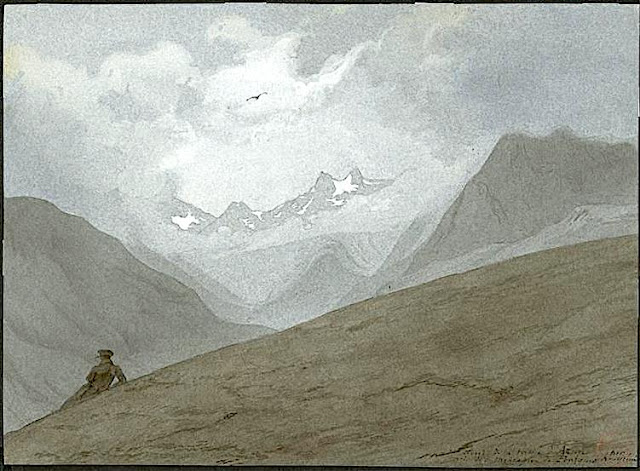
Les Grands Mulets (refuge à 3051m)
France (Haute-Savoie)
In " La jonction au-dessus des Grands Mulets " 1869, Médiathèque de l’Architecture et du Patrimoine, Charenton-le-Pont, France
Les Grands Mulets (3051m) est un refuge situé dans le Massif du Mont-Blanc en France, dans le département de la Haute-Savoie en région Auvergne-Rhône-Alpes. Situé sur une des voies d'accès du Mont Blanc, très prisée par les skieurs, dans un univers glacier de haute montagne, il appartient au Club alpin français. Ce refuge est équipé du gaz, de couvertures et du nécessaire de cuisine. Le refuge actuel a été construit en 1960 et inauguré le 7 août, il remplace le précédent refuge construit en 1896. Le premier refuge des Grands Mulets, l'un des précurseurs de ce type, fut construit en 1853 avec une charpente en bois transportée à dos d'hommes et de mulets.
Eugène Viollet-le-Duc est un architecte français. Aujourd'hui, il est surtout connu auprès du grand public pour ses restaurations de constructions médiévales, édifices religieux et châteaux dont Notre-Dame de Paris, Pierrefonds, Carcassonne, le mont Saint-Michel et le château de Roquetaillade. Mais Viollet-le-Duc est aussi historien, théoricien, pédagogue, dessinateur, professeur, écrivain, décorateur, archéologue, alpiniste...
Il écrit plus de cent ouvrages dont certains auront un succès international et sont toujours publiés aujourd'hui : le Dictionnaire raisonné de l’architecture française du XIe au XIVe siècle, Entretiens sur l'architecture et son Histoire d'une Maison.
Ses ouvrages sont toujours accompagnés d'une dense iconographie pédagogique permettant ainsi la compréhension de ses livres, ce qui explique, entre autres, son succès à l'étranger.
Son Dictionnaire raisonné de l’architecture française du XIe au XIVe siècle contient plus de 3 700 dessins et reste aujourd'hui la plus grande base de données iconographiques existante sur le Moyen Âge. Ce livre aura une influence sur l'Arts and Crafts et le style Victorien en Grande-Bretagne, mais aussi sur tous les mouvements du renouveau gothique en Europe. Ses dessins et ses idées seront repris et copiés par de nombreux architectes, tels William Burges, Anton Gaudi, Hector Guimard... On retrouve l’influence des dessins du Dictionnaire directement dans l’esthétisme des œuvres Arts and Crafts de Edward Burne-Jones, Dante Gabriel Rossetti et William Morris à l’Exposition Universelle de Londres en 1862.
Il pose les bases de l'architecture moderne par ses écrits théoriques marqués par le rationalisme. Son livre Entretiens sur l'architecture est considéré « comme fondateur de l'architecture moderne ». Ce livre préconisera aussi l’utilisation de matériaux modernes en architecture comme le fer, ce qui influencera la construction du premier gratte-ciel à Chicago (1885) par Le Baron Jenney, qui dira de Viollet le Duc « ses recherches et ses trouvailles dépassent tout ce qu’un autre auteur a pu écrire ». De son côté Frank Lloyd Wright affirmera que « les Entretiens était le seul livre sensé sur l'architecture au monde .
Il est aussi considéré aujourd'hui comme le théoricien incontesté de l'Art Nouveau et en sera avec presque trente ans d'avance le premier protagoniste.
______________________________________
2024 - Gravir les montagnes en peinture
Un blog de Francis Rousseau




